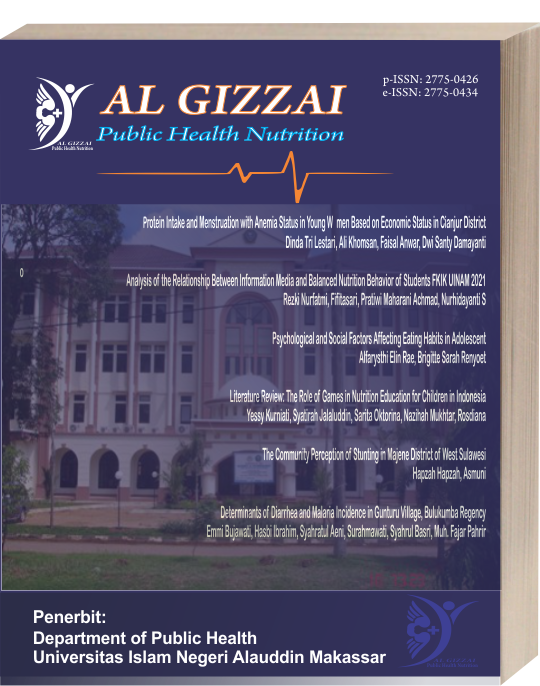Analysis of the Relationship Between Information Media and Balanced Nutrition Behavior of Students FKIK UINAM 2021
Abstract
Media information is a medium that can make it easier to find out information widely. This study aims to determine the effect of information media on balanced nutrition behavior in FKIK UINAM 2021 students. This study uses a quantitative research type with a cross sectional approach. The population in this study were all students of FKIK UINAM Class of 2018-2020. The number of samples as many as 182 with a sampling technique using purposive sampling. sample size using the Lemeshow formula. The research instrument is a questionnaire. Data analysis using chi-square test. The results of the study found that there was an relationship between good information media and good behavior on balanced nutrition with the results of the chi square statistic test obtained p-Value 0.004. so it can be concluded that the better we get information about balanced nutrition, the better our behavior in implementing balanced nutrition will be. . This is because when someone gets information, the knowledge about balanced nutrition increases so that they can apply balanced nutrition behavior properly. Researchers recommend to students to be more intense in seeking information from various sources regarding balanced nutrition.
References
Caesar, D. L., & Prasetya, B. A. (2020). Efektifitas Media Poster Dalam Meningkatkan Pengetahuan Sanitasi Dasar Di Sdn 01 Wonosoco Undaan Kudus In Improving Basic Sanitation Knowledge. 6(1), 83–91.
Cahyono, A. S. (n.d.). Anang Sugeng Cahyono, Pengaruh Media Sosial Terhadap Perubahan Sosial Masyarakat di Indonesia. 140–157.
Doni, F. R. (2017). Perilaku Penggunaan Media Sosial Pada Kalangan Remaja. 3(2), 15–23.
Dorey, E., & McCool, J. (2009). The role of the media in influencing children’s nutritional perceptions. Qualitative Health Research, 19(5), 645–654. https://doi.org/10.1177/1049732309334104
Fauzi, C. A. (2012). Analysis of The Knowledge and Behaviour of Adolescents Based on The General Guidelines of Balanced Nutrition ( PUGS ) Point 6 , 10 , 11 , and 12.
F., Madanijah, S., & Ekayanti, I. (2017). Pengembangan media edukasi gizi berbasis android dan website serta pengaruhnya terhadap perilaku tentang gizi. 12(November), 169–178. https://doi.org/10.25182/jgp.2017.12.3.169-178
Irnani, H., & Sinaga, T. (2017). Pengaruh pendidikan gizi terhadap pengetahuan , praktik gizi seimbang dan status gizi pada anak sekolah dasar. 6(1), 58–64.
Lathifa, S., & Mahmudiono, T. (2019). Pengaruh Media Edukasi Gizi Berbasis Web Terhadap Perilaku Makan Gizi Seimbang Remaja Sma Surabaya the Effect of Web-Based …. Mgk Journal, 4(August), 4–9. https://www.e-journal.unair.ac.id/MGK/article/view/20950
Martony, O. (2019). The Influence of Balanced Nutrition Extension Through Poster Media on the Improvement of Knowledge and Change Attitude. International Journal of Science and Society, 1(1), 98–106. https://doi.org/10.54783/ijsoc.v1i1.153
Pakhri, A., Gizi, J., Kesehatan, P., & Makassar, K. (2014). Asupan Energi , Protein Dan Besi Pada Remaja. 39–43.
J., No, V., April, E., & T, S. M. (2019). Pemanfaatan Internet Sebagai Media Informasi Pendidikan Pancasila. 4(1), 64–73.
J. K., & Suri, D. (2019). Pemanfaatan Media Komunikasi Dan Informasi Utilization of Communication Media and Information for Embody National. 17(2), 177–187.
Rafiq, A. (2015). dilengapi dengan fasilitas yang disediakan dalam berkomunikasi semakin beraneka macam, mulai dari. 18–29.
Riza, ifroh H. (2019). peran petugas promosi kesehatan dalam penggunaan audiovisual sebagai media komunikasi informasi dan edukasi. 7(2), 281–289.
Tengku, H. (2018). Pengaruh Edukasi Pedoman Gizi Seimbang Terhadap Pengetahuan dan Sikap Remaja Putri Kurus. 2(2), 90–99.
Copyright (c) 2022 Rezki Nurfatmi

This work is licensed under a Creative Commons Attribution-NonCommercial-ShareAlike 4.0 International License.
Authors retain copyright and grant the journal right of first publication with the work simultaneously licensed under a Creative Commons Attribution-NonCommercial-ShareAlike 4.0 International License that allows others to share the work with an acknowledgment of the work's authorship and initial publication in this journal.
Authors are able to enter into separate, additional contractual arrangements for the non-exclusive distribution of the journal's published version of the work (e.g., post it to an institutional repository or publish it in a book), with an acknowledgement of its initial publication in this journal.
Authors are permitted to publish their work online in third parties as it can lead to wider dissemination of the work.










